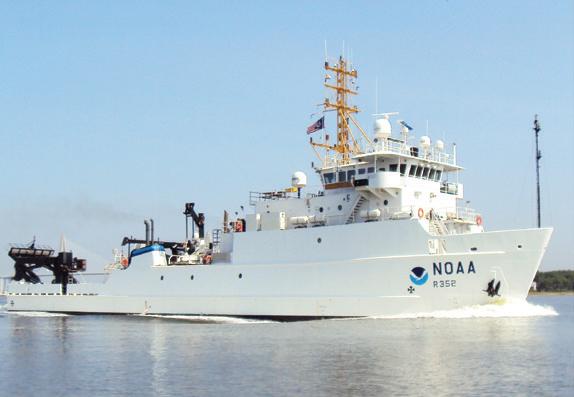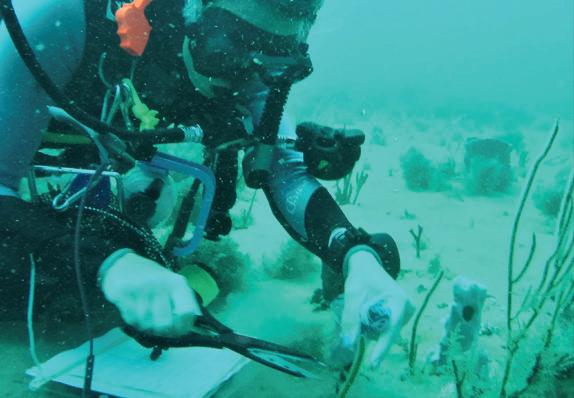
4 minute read
Around the Reef
By Portia Miller Communications Intern Gray’s Reef National Marine Sanctuary
Who doesn’t enjoy summer out at sea? After a missed year, scientists from Gray’s Reef National Marine Sanctuary and beyond are ready to embark again on the annual Nancy Foster Research Expedition. However, this isn’t a leisurely cruise. The scientists will work day and night running new experiments along with ongoing projects to learn more about Gray’s Reef and its creatures. This year, the expedition runs from Aug. 7 to Aug. 18. Let’s dive in!
Advertisement
The journey begins at a port in Charleston, SC, where scientists from Gray’s Reef, other NOAA offices, research organizations, and universities board the NOAA Ship Nancy Foster to conduct the expedition. With nearly 200 feet of space, the ship can house multiple scientists and their tools. The ship has its own set of equipment too, which makes it shine – especially in its mapping abilities. The main method used on the Nancy Foster for mapping, which creates a 3D picture of the ocean floor, is the multibeam sonar system. Under careful use by trained NOAA crew members, the sonar system sends out multiple sound waves below the boat in a fan-like pattern. The time it takes for the beams to hit the bottom of the ocean and return to the sensors determines seafloor depth and reveals the seabed’s shape. Another important component, called backscatter, measures how strong the returning sound waves are. Backscatter can determine what the seafloor is made of since some materials, like rocks, reflect more sound than sand reflects. The expedition’s Chief Scientist is Kimberly Roberson, the sanctuary’s research coordinator and ecologist. She and Gray’s Reef’s geospatial data analyst, Alison Soss, will be working with NOAA survey technicians and NOAA Corps officers to create a detailed habitat map of the reef using the ship’s mapping technology. The map will help them visualize and understand the reef’s hard bottom environment and assist in identifying similar areas nearby.
Some of the more hands-on excitement comes from studying the sanctuary’s marine life, which means scientists must get their feet wet! Roberson and Soss will experience this firsthand. The pair will put on their heavy scuba gear and dive underwater to observe some of the animals that call the reef home. With a water-proof clipboard in hand, they’ll survey the number of fish and spineless creatures, known as invertebrates, found in selected areas of the sanctuary. While much of their work revolves around Gray’s Reef’s designated Research Area (RA), this year’s survey takes them outside of RA bounds, where they’ll analyze fish distribution and habitat characteristics throughout the waters. Other projects, such as Georgia Southern University professors Dr. Craig Aumack and Dr. Risa Cohen’s assessment of algae, require divers to carefully collect samples from the bottom of the reef. Once divers get a chance to dry off, they’ll send their specimens to the boat’s laboratories to investigate and document what they’ve found. These projects are vital to understanding the ecology of Gray’s Reef and help sanctuary managers make informed decisions.
Discovering new information about the reef can be fascinating, but monitoring threats is also a focus of the missions. These threats come from many sources, including other creatures of the sea. Divers and researchers aboard the Nancy Foster work each year to catch, examine, and remove the invasive lionfish. These fish, originally from the Indo-Pacific Ocean, are expert survivors with almost no natural predators. Lionfish can out-compete native species for food and space. To control their population, divers led by the sanctuary’s Georgia Sea Grant Fellow, Alexi Archer, will search for lionfish that are near Gray’s Reef and collect them. Archer will compile written records of their findings to help scientists better understand these invasive animals’ habits.
Some potential threats are a bit more subtle. This year, Master’s student Savannah Geiger from Savannah State University is studying the distribution of microplastics in the reef, which are bits of plastic, five millimeters long or less. Microplastics can come from all sorts of places, such as larger ocean debris or beauty products like bath gels. Little is currently known about the dangers of microplastics, but understanding their abundance and structure can give scientists a leg up in the future.
The Nancy Foster Research Expedition scientists are excited to get back to the reef, and their hard work is showing in this year’s round of experiments. We look forward to their findings, which guide us in protecting the wonders of Gray’s Reef for the future. To learn more about this year’s expedition, visit the Gray’s Reef website at graysreef.noaa.gov and check out our Facebook page at facebook. com/graysreefsanctuary.
For Information contact Michelle Riley: michelle.riley@noaa.gov
Above: NOAA Ship Nancy Foster, underway. Photo by Ens. Conor Maginn/NOAA Below: Alicia Reigel collecting coral samples at Gray's Reef. Photo by Executive Officer Faith Knighton











